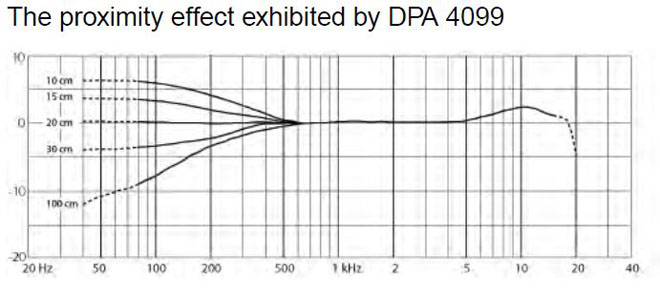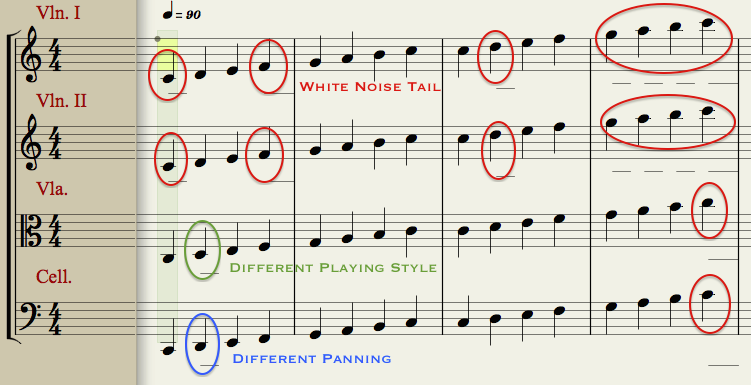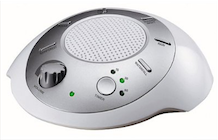Johnny wrote:My use of the term "White Noise" is in reference to a mechanical sound which is always present in the process of sound generation from a bowed string instrument. This "noise" is for the most part undesirable because of it's "percussive" non-harmonic effect. I therefore use "White Noise" to define it since it is constant in a poorly sampled sound file (instrument or audio file).
This is the way I use the term "white noise", and there is an example audio clip of white noise on the right side of the page . . .
[
NOTE: White noise is the noise that ocean waves make at the beach, and it also is made by wind blowing through leaves and by rain. In some scenarios it is comforting and is used in portable machines that mask city noises and by doing so help people sleep without being distracted. It also is part of the sound made by waterfalls. However, at higher volume levels, it is annoying . . . ]
White Noise (Wikipedia)There are several different colors of noise, as explained at this link:
[
NOTE: Pink Noise is used when configuring a sound system to tailor it to a specific venue, and this also is the case when calibrating a studio monitor system using a real-time analyzer and equalizer like the Behringer DEQ2496 UltraCurve Pro Mastering Processor (a personal favorite) . . . ]
Colors of Noise: Technical Definitions (Wikipedia)Johnny wrote:"Proximity effect" causes a increase in bass frequency response. That is why I'm suggesting the effect covers or masks the lower amplitude of a bow sliding across a vibrating string not accentuating it.
In some respects, this might work for a string bass and possibly for a cello, although not so much for a viola or violin; but the basic problem with the hypothesis is that the offending noise is
not low-frequency--instead it is midrange and high frequency . . .
Intuitively, I would expect less undesired bowing noise with the DPA 4099b pointed downward rather than upward, and this is the way it is shown in the photograph . . .
There is a good bit of room for doing the same thing with a cello, but the available room decreases significantly with a viola or violin, as does the ability of the instruments to produce bass tones . . .
There are similar small microphones for violas and violins, but they usually are used in
Pop,
Country Western,
Bluegrass,
Rhythm and Blues,
Jazz, and other genres where there is a sound reinforcement system and all the musicians and singers are amplified for purposes of performing before an audience; but this certainly can include recording studio usage, although
not necessarily, since there are different considerations in the recording studio scenarios . . .
As best as I can determine, most of the sampled sound libraries are recorded either (a) in concert halls under controlled conditions with professional recording equipment or (b) in professional recording studios with essentially the same type of equipment; and the fact of the matter regarding microphones is that some of them cost more than everything in a typical home recording studio (analog or digital), and this includes instruments, microphones, computers, software, various hardware, furniture, acoustic treatments, studio monitor systems, cables, and so forth . . .
[
NOTE: The highest price microphones are older, but even with new microphones there are quite a few in the $3,000 (US) to $7,500 (US) range. Generally, I think that a reasonably complete home studio tailored primarily for working with virtual instruments; a few but not so many real instruments; and real singing costs somewhere in the range of $15,000 (US) to $25,000 (US), including a few professional quality instruments used primarily in popular music genres. On a related note, I like some of the inexpensive MXL condenser and ribbon microphones that cost approximately $50 (US) each when Musician's Friend has a super discount sale, which is considerably easier of the budget . . . ]
If the "white noise" problem were universal, then it would happen with recordings of orchestras and string ensembles in a variety of scenarios, including concert halls and professional recording studios like Abbey Road Studios, but it does not appear to happen in any of those settings--except in the specific scenario where instruments are being recorded for purposes of making sampled sound libraries . . .
SUMMARYEverything about microphones is important, and this includes the proximity effect; but this is part of the "recording" step, which is
not the only step . . .
Once the raw audio is recorded, produced, and mastered for purposes of being the input to the next step, which is the digitizing step, the factors change; the focus is different; and microphones are
not part of this step . . .
Whatever the microphones did already is done; and it is made permanent as part of the audio clips--specifically the audio clips that are the output of the recording step but are the input to the digitizing step . . .
In other words, at the recording step, microphones are a variable; but when the recording step is completed and the audio clips are finalized, the microphones become a constant rather than a variable . . .
Based on what I have heard so far, the way samples are recorded in some instances might be a problem; but there are other indications that the real problems most likely occur during the digitizing step rather than during the recording step; and some of the problems occur based on the ways end users produce songs that have virtual instruments, which is something that
JohnF suggested as a possibility, where the example is adding a compressor-limiter, which typically would raise the level of the tails of notes arbitrarily and by doing so would amplify the perhaps otherwise tolerable white noise in the background, thereby moving it to the foreground, noting that I do not think this is a matter of dithering or not dithering . . .
Lots of FUN! 
P. S. Regarding the graph of the proximity effect and the DPA 4099b condenser microphone, it is important to consider the equal loudness curves when putting the information into context . . .
[
NOTE: Based on the information provided in the "proximity effect" graph for the DPA 4099, it has no proximity effect below 40-Hz, which essentially is just a tiny bit below the low-pitch "E" string (41.203-Hz) at standard tuning ("Concert A" = 440-Hz) and the proximity effect from 40-Hz to 80-Hz is represented by dotted or dashed lines rather than the solid lines that start at 80-Hz, where the key bit of information is that while the "frequency range" of the microphone is stated to be "20-Hz to 20,000-Hz", there also is a second frequency range stated for plus or minus 2 dB, but it is 80-Hz to 15-kHz, which is fine with me, although I am a bit puzzled by the dotted or dashed lines and what they indicates as contrasted to the solid lines . . . ]


Unless the bass notes are in the range of 85 dB SPL to 90 dB SPL, they will not have much "masking" affect on midrange and high frequencies . . .
The troublesome frequency range with respect to noise is the "dip" centered at approximately 3,000-Hz, which is where normal human hearing is most sensitive, and this is part of the midrange region . . .
Bass also is troublesome, but it is a different type of trouble, which specifically is that as shown by the equal loudness curve(s), it requires considerably more power to hear bass at the same perceived loudness as midrange and high frequencies, which among other things is the reason that with only one exception (JBL Professional M2 Master Reference Studio Monitors, which cost $20,000 [US]), commercial-off-the-shelf (COTS) studio monitor systems need to be augmented with a pair of deep bass subwoofers, which essentially double the price of a studio monitor system. Absent the pair of deep bass subwoofers, COTS studio monitor systems are
not full-range, which is a big problem, because the only way to hear music accurately when producing, mixing, and mastering is to listen to it played through a calibrated full-range studio monitor system. Headphones do
not work, and there is no other way to hear the music accurately . . .


